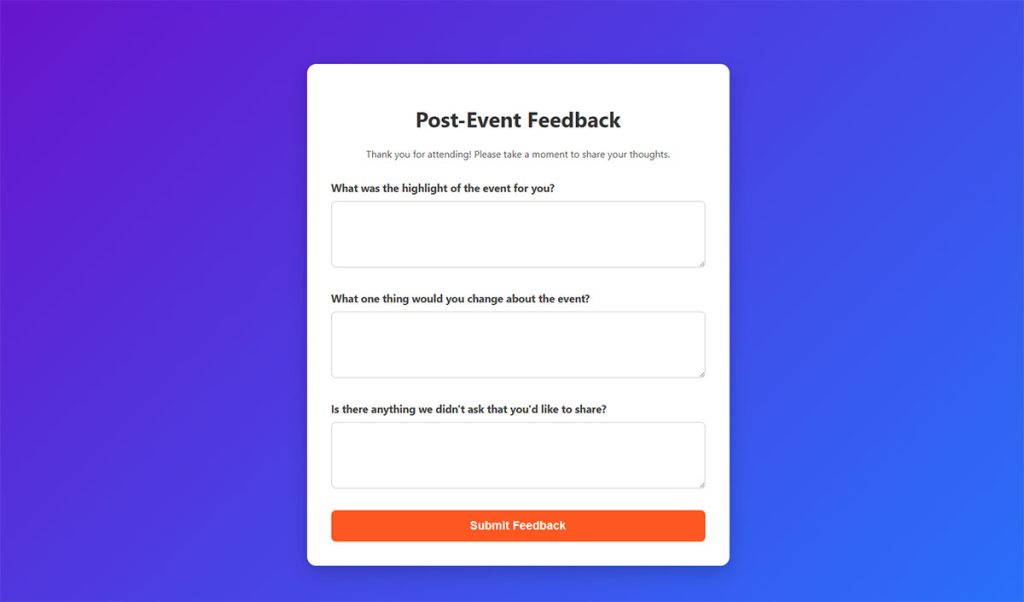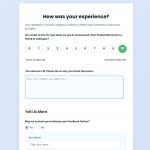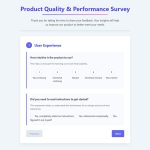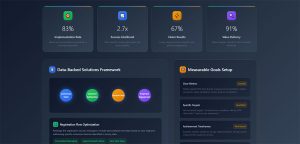You send a survey. Half your audience ignores it. The other half quits halfway through. Sound familiar? Survey fatigue is killing your response rates and destroying data quality. When participants…
Table of Contents
Getting honest attendee feedback can transform your next event from good to exceptional. Yet many organizers struggle to craft questions that actually drive meaningful insights.
Post-event survey questions serve as your direct line to understanding what worked, what failed, and what needs improvement. Without this critical data, you’re essentially planning blind for future events.
Smart event professionals recognize that effective post-conference questionnaires go beyond basic satisfaction ratings. They dig deeper into attendee experiences, speaker performance, and venue logistics to uncover actionable feedback.
This guide will equip you with proven survey templates and response optimization techniques that boost completion rates. You’ll discover how to structure questions that generate valuable participant insights while avoiding common survey pitfalls.
From timing your feedback distribution to analyzing response metrics, we’ll cover everything needed to build a robust event evaluation system that delivers real results.
Post-Event Survey Questions
Basic Attendee Information
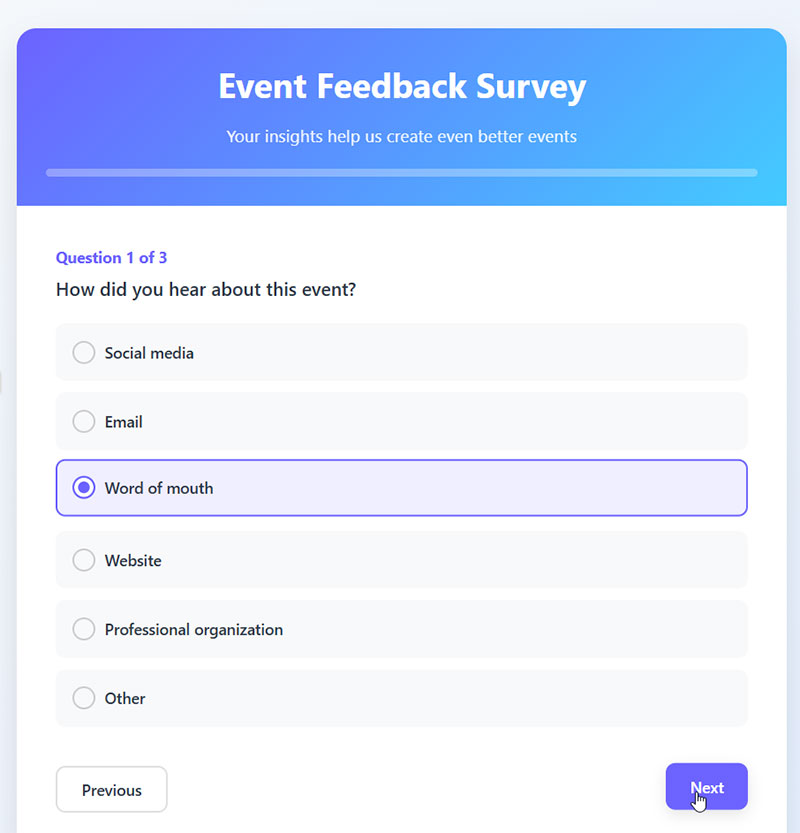
Event Discovery Source
Question: How did you hear about this event?
Type: Multiple Choice (Social media, Email, Word of mouth, Website, Professional organization, Other)
Purpose: Identifies your most effective marketing channels.
When to Ask: Beginning of the survey to ease participants in.
First-Time Attendance
Question: Was this your first time attending our event?
Type: Yes/No
Purpose: Helps segment feedback between new and returning attendees.
When to Ask: Early in the survey for segmentation purposes.
Attendance Motivation
Question: What was your primary reason for attending?
Type: Multiple Choice (Professional development, Networking, Specific speaker/topic, Company requirement, Other)
Purpose: Reveals attendee motivations and expectations.
When to Ask: Beginning section to understand baseline intentions.
Event Experience
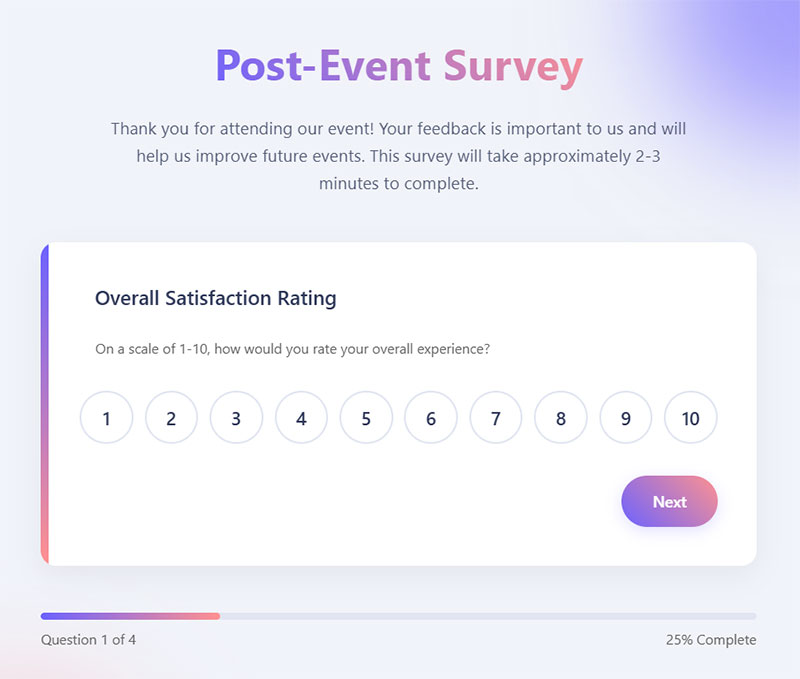
Overall Satisfaction Rating
Question: On a scale of 1-10, how would you rate your overall experience?
Type: Numeric Scale (1-10)
Purpose: Provides a quantifiable metric of general satisfaction.
When to Ask: Near the beginning to capture overall impression before specific questions.
Most Valuable Component
Question: Which session or activity did you find most valuable?
Type: Dropdown (List of all sessions/activities)
Purpose: Identifies strongest content for future planning.
When to Ask: After asking about overall experience to drill into specifics.
Positive Surprises
Question: Which aspects of the event exceeded your expectations?
Type: Open-ended
Purpose: Uncovers unexpected strengths and delighters.
When to Ask: Mid-survey to capture positive feedback.
Disappointment Points
Question: What aspects fell short of your expectations?
Type: Open-ended
Purpose: Highlights improvement areas and pain points.
When to Ask: After positive feedback to balance response tone.
Content & Programming
Content Relevance
Question: Was the content relevant to your needs?
Type: Likert Scale (Strongly disagree to Strongly agree)
Purpose: Assesses alignment between content and attendee needs.
When to Ask: When exploring content quality specifically.
Speaker Expertise
Question: Did the speakers demonstrate expertise in their topics?
Type: Likert Scale (Strongly disagree to Strongly agree)
Purpose: Evaluates speaker selection and performance.
When to Ask: In the content evaluation section.
Session Duration
Question: How appropriate was the length of each session?
Type: Multiple Choice (Too short, Just right, Too long)
Purpose: Helps optimize session timing for future events.
When to Ask: When discussing event structure and pacing.
Break Adequacy
Question: Were there enough breaks between sessions?
Type: Likert Scale (Strongly disagree to Strongly agree)
Purpose: Evaluates event pacing and attendee comfort.
When to Ask: After questions about session duration.
Logistics & Organization
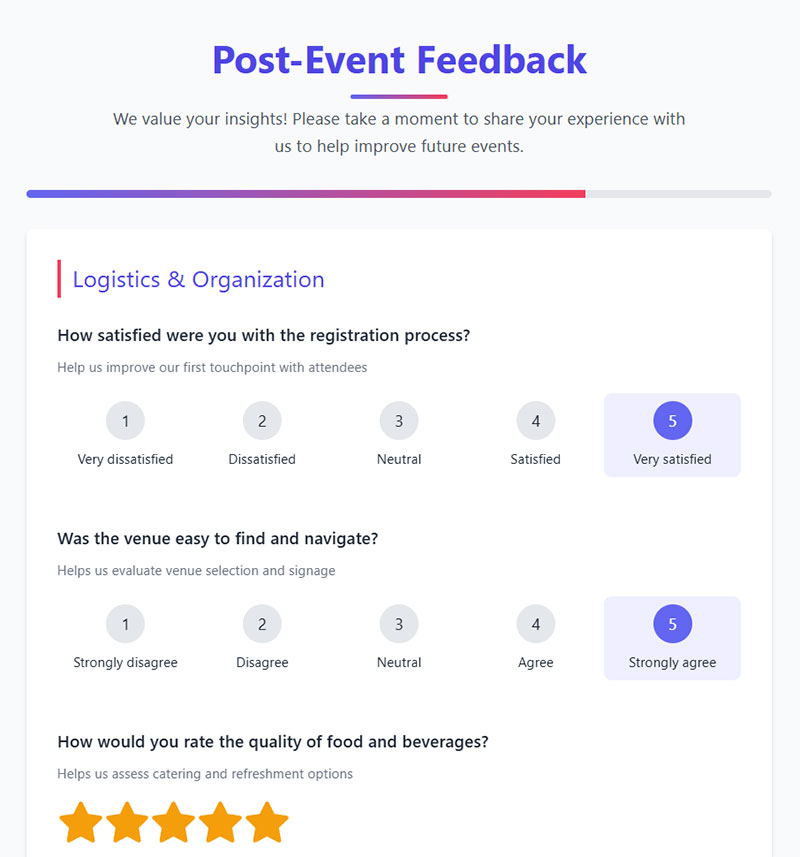
Registration Experience
Question: How satisfied were you with the registration process?
Type: Likert Scale (Very dissatisfied to Very satisfied)
Purpose: Assesses first touchpoint efficiency.
When to Ask: When transitioning to logistics questions.
Venue Navigation
Question: Was the venue easy to find and navigate?
Type: Likert Scale (Strongly disagree to Strongly agree)
Purpose: Evaluates venue selection and signage.
When to Ask: During logistics section.
Refreshment Quality
Question: How would you rate the quality of food and beverages?
Type: Star Rating (1-5 stars)
Purpose: Measures satisfaction with catering and refreshments.
When to Ask: Within the logistics and amenities section.
Scheduling Adherence
Question: Did the event start and end on time?
Type: Yes/No with optional comment
Purpose: Assesses event management professionalism.
When to Ask: During operational questions portion.
Technology & Resources
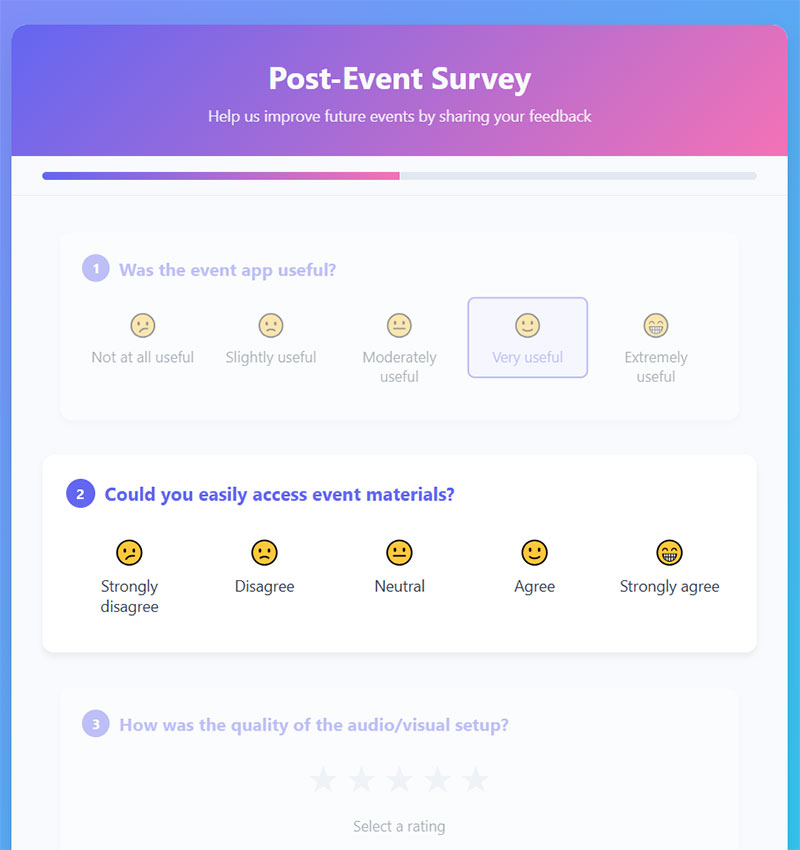
App Utility
Question: Was the event app useful?
Type: Likert Scale (Not at all useful to Extremely useful)
Purpose: Evaluates digital tool effectiveness.
When to Ask: When focusing on technology aspects.
Materials Accessibility
Question: Could you easily access event materials?
Type: Likert Scale (Strongly disagree to Strongly agree)
Purpose: Assesses information distribution effectiveness.
When to Ask: Within technology and resources section.
AV Quality
Question: How was the quality of the audio/visual setup?
Type: Star Rating (1-5 stars)
Purpose: Evaluates technical production aspects.
When to Ask: When asking about presentation quality.
Technical Issues
Question: Did you experience any technical difficulties?
Type: Yes/No with open comment field
Purpose: Identifies specific technical problems for resolution.
When to Ask: After other technology questions.
Networking Opportunities
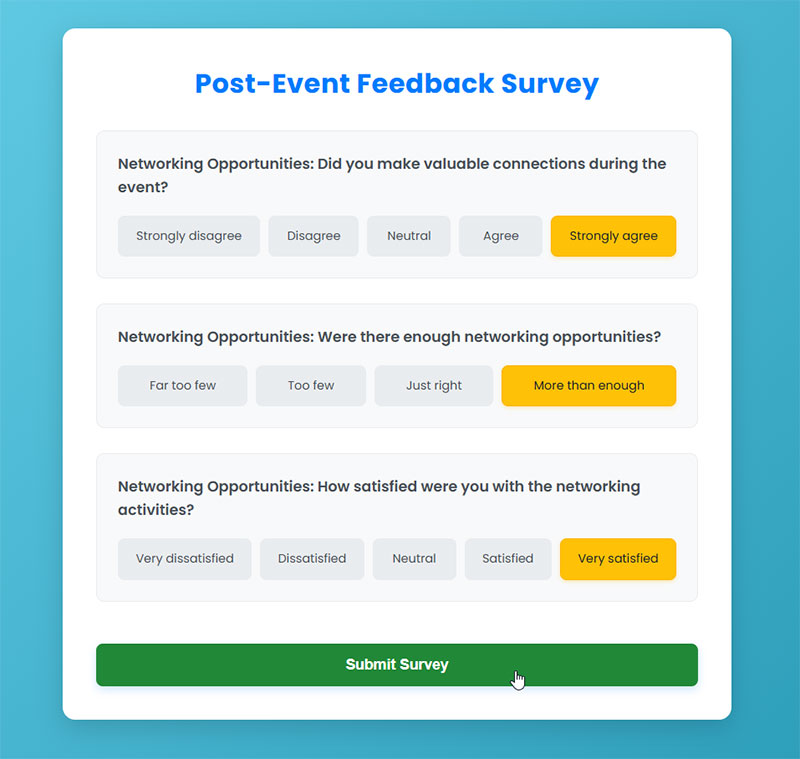
Connection Value
Question: Did you make valuable connections during the event?
Type: Likert Scale (Strongly disagree to Strongly agree)
Purpose: Measures networking effectiveness.
When to Ask: When focusing on interpersonal aspects.
Networking Sufficiency
Question: Were there enough networking opportunities?
Type: Likert Scale (Far too few to More than enough)
Purpose: Evaluates programming balance.
When to Ask: During networking section.
Networking Activities Satisfaction
Question: How satisfied were you with the networking activities?
Type: Likert Scale (Very dissatisfied to Very satisfied)
Purpose: Assesses quality of structured networking opportunities.
When to Ask: After asking about quantity of networking.
Value & Impact

Time Investment Value
Question: Did the event deliver value for the time invested?
Type: Likert Scale (Strongly disagree to Strongly agree)
Purpose: Measures perceived ROI for attendees.
When to Ask: When transitioning to impact questions.
Implementation Intentions
Question: What key insights will you implement after this event?
Type: Open-ended
Purpose: Identifies actionable takeaways and practical impact.
When to Ask: When exploring event outcomes.
Perspective Change
Question: Has this event changed how you think about [topic]?
Type: Likert Scale with optional comment
Purpose: Measures transformative impact of content.
When to Ask: During value assessment section.
Future Events
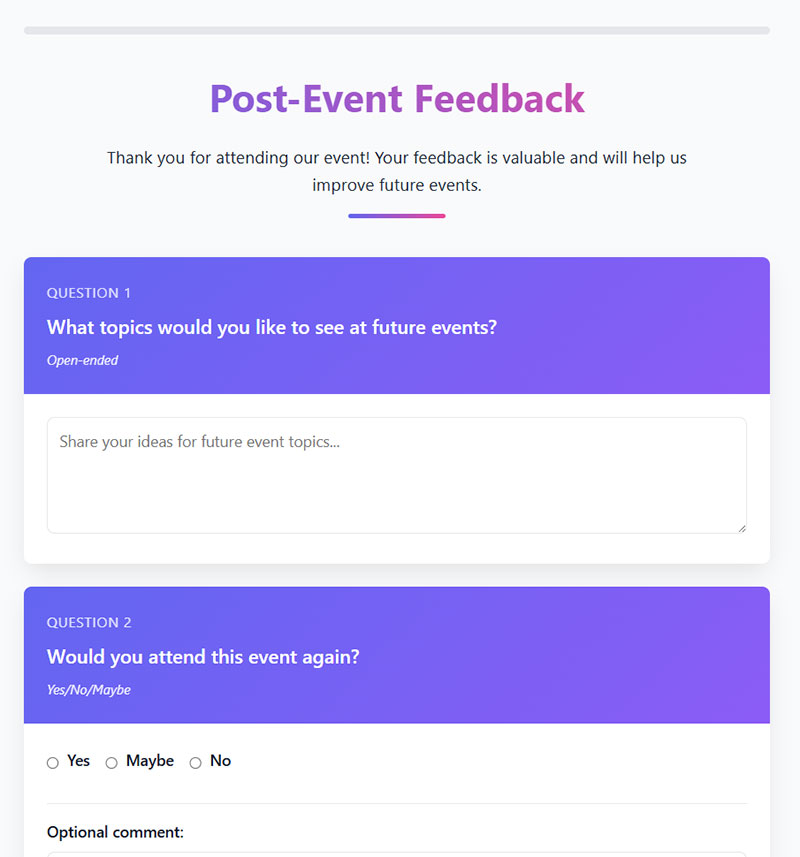
Future Topic Requests
Question: What topics would you like to see at future events?
Type: Open-ended
Purpose: Gathers content ideas for future planning.
When to Ask: When transitioning to forward-looking questions.
Repeat Attendance Likelihood
Question: Would you attend this event again?
Type: Yes/No/Maybe with optional comment
Purpose: Measures satisfaction and loyalty.
When to Ask: Near the end of core questions.
Recommendation Likelihood
Question: How likely are you to recommend this event to others?
Type: NPS Scale (0-10)
Purpose: Measures word-of-mouth potential using standard NPS methodology.
When to Ask: Near the end as a summary metric.
Specific Improvement Suggestions
Question: What specific improvements would make you more likely to attend in the future?
Type: Open-ended
Purpose: Collects actionable feedback for event enhancement.
When to Ask: Near the end for constructive input.
Open Feedback
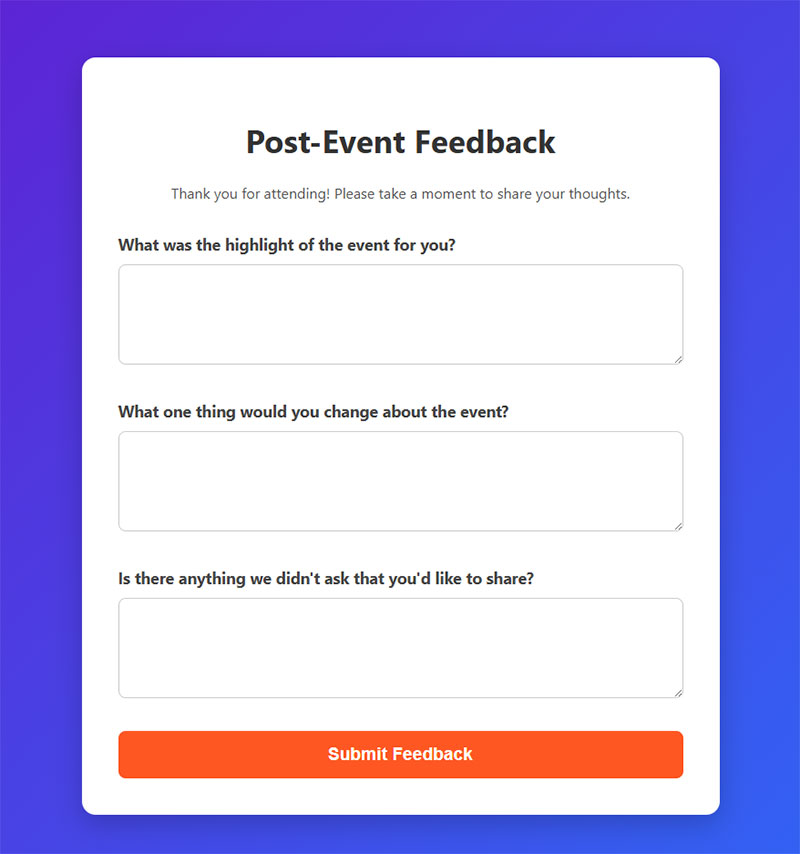
Event Highlight
Question: What was the highlight of the event for you?
Type: Open-ended
Purpose: Identifies most memorable positive aspects.
When to Ask: During wrap-up questions.
Single Change Request
Question: What one thing would you change about the event?
Type: Open-ended
Purpose: Forces prioritization of improvement suggestions.
When to Ask: Near the end to capture final thoughts.
Additional Comments
Question: Is there anything we didn’t ask that you’d like to share?
Type: Open-ended
Purpose: Catches any missed feedback areas.
When to Ask: As the final question.
FAQ on Post-Event Survey Questions
When should I send my event feedback survey?
Send your event evaluation questionnaire within 24-48 hours after the event concludes. This timing captures fresh attendee impressions while maintaining strong response rates. For virtual events, consider sending immediately after the session ends.
What’s the optimal survey length?
Keep surveys to 10-15 questions maximum. Research shows completion rates drop significantly beyond this threshold. Focus on essential attendee satisfaction metrics rather than comprehensive data collection.
Which question types work best?
Mix rating scales (Likert scale), multiple-choice, and open-ended questions. Net Promoter Score (NPS) questions provide valuable benchmarking data. Limit open-ended responses to 2-3 strategic points.
How can I increase survey completion rates?
Offer incentives, optimize for mobile devices, and clearly communicate completion time. Use survey automation tools to send personalized reminders. Keep form design simple and progress indicators visible.
What questions should I always include?
Overall satisfaction rating, likelihood to recommend (NPS), specific session feedback, venue quality assessment, and one improvement suggestion. These core participant satisfaction metrics enable consistent event benchmarking.
Should I make questions mandatory?
Required fields reduce completion rates. Make only critical questions mandatory while using conditional logic to show relevant follow-ups based on responses.
How do I handle negative feedback?
Create a feedback implementation plan that categorizes responses by priority. Address critical issues immediately while scheduling improvements for future events. Thank respondents for honest input.
Which survey platform should I use?
Choose platforms offering WordPress survey plugins compatibility, response analytics dashboards, and mobile optimization. Consider integration with your event management software for streamlined data collection.
How do I analyze survey results effectively?
Use survey result visualization tools to identify trends. Compare metrics against industry benchmarks and previous events. Focus on actionable insights rather than vanity metrics.
Can I reuse survey templates?
Yes, but customize survey form templates for each event type. Virtual event surveys need different questions than conference evaluation forms. Build a question bank for consistent measurement.
Conclusion
Mastering post-event survey questions requires balancing comprehensive feedback collection with participant experience. Your event success metrics depend on gathering actionable attendee insights through well-crafted questionnaires.
Implementing the strategies outlined transforms basic feedback forms into powerful event improvement tools. Key takeaways include:
- Timing matters: Send surveys within 48 hours
- Keep it focused: 10-15 questions maximum
- Mix question types: Combine ratings, multiple-choice, and open-ended
- Analyze strategically: Use feedback categorization systems
Remember that survey response rates directly impact your event ROI measurement capabilities. Consider investing in specialized event technology solutions that streamline distribution and analysis.
Your attendee sentiment analysis becomes the foundation for continuous improvement. Each feedback loop creates opportunities to enhance future events, boost sponsor visibility, and increase participant satisfaction.
Start building your event quality assurance system today. With proper survey automation and robust analytics dashboards, you’ll transform raw feedback into strategic planning insights that elevate every aspect of your event portfolio.


